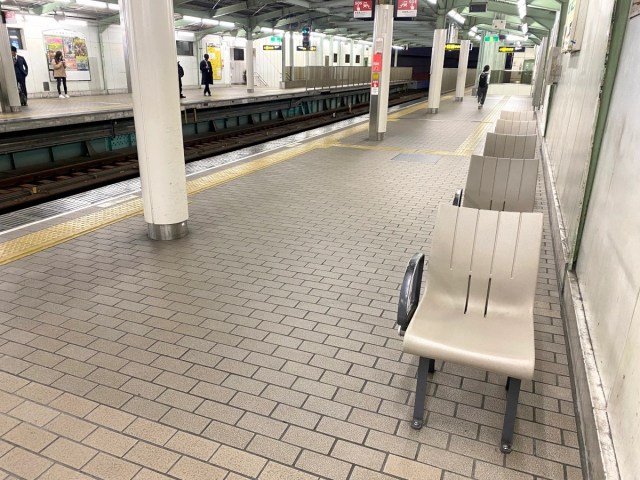
Unusual design in Kansai is a clever example of thoughtful customer service, designed specifically with the user in mind.
Osaka, in the Kansai region, and Tokyo, in the Kanto region, pride themselves on doing things differently from each other, whether it involves rice balls at a convenience store or the way miso soup is positioned at the table.
The differences don’t stop at food, however, because at train stations in the Kansai area, you’ll find that seats on some platforms look very different from those in Tokyo.
▼ An example of seats at a Tokyo train station…
▼ …and an example of seats at a train station in Osaka.
Our Tokyo-based reporter P.K. Sanjun took a trip to Osaka recently, and when he saw the seats he couldn’t help but wonder about the real reasons behind their design. Was this simply another case of Osaka doing things differently to Tokyo? Or was there another factor at play here?
In order to find out, he went straight to the local railway operator, West Japan Railway Company, to ask them why the seats are positioned away from the trains and their tracks, and they revealed three fascinating reasons for the design.
P.K.: I’ve seen this at stations in Osaka and Hyogo so I wanted to ask — why are the seats facing parallel to the platform? It’s something you don’t see in Kanto…”
JR West: “Well, the main reason is to prevent drunken customers from falling (onto the tracks). Until they were installed, there were numerous cases where drunk customers who’d been sitting on the seats stood up and fell off the platform.”
P.K.: “So it’s to prevent drunken people from falling off the platform? Does that mean the design was different before?”
JR West: “Yes, it would take some time for me to check when they were formally introduced, but from what I remember the new seat configurations first appeared around five to six years ago.”
P.K.: “Hmmm. But if the purpose is to prevent falls, shouldn’t platform doors be installed instead? I feel like I’m seeing a lot more of them at stations in the city centre.”
JR West: “I understand what you’re saying. However, Kansai has a complicated network of routes, so it may be a little difficult to install platform doors everywhere. Major stations such as Osaka, Tsuruhashi, Kyobashi, and Sannomiya have platform doors, though.”
▼ Compared to Osaka, Tokyo currently has a lot more of these platform doors installed at stations.
P.K.: “I see. I guess the installation of platform doors must be very costly. Seats might be a more cost-effective countermeasure.”
JR West: “I don’t know the details of the cost, but I think that’s probably part of the reason. JR West has been changing the seat positions at a large number of station platforms over the past few years.”
P.K.: “Well, that clears things up! Thank you!”
Following his conversation with JR West, P.K. discovered that the main reason for the unusual seat positioning was to protect drunken customers from falling off the platform. And sure enough, when he was passing through another station in the region, he found a poster showing the change in the position of the seats, along with an explanation that the new configuration was designed to protect against drunken falls.
Drunken falls are a big problem at train stations throughout Japan, so much so that you’ll commonly find posters warning commuters of the dangers. It’s one of the reasons why platform doors are being installed at a number of stations but given the costs involved, and the fact that Japan’s rail network is wide and varied, a nationwide rollout would be a difficult and time-consuming task.
Still, while there are hurdles to making hurdles, that doesn’t mean a railway operator in Japan will sit on its hands and claim nothing can be done to fix the problem. So kudos to JR West for looking for an alternative solution and coming up with the simple yet effective idea to change the position of the seats.
▼ A simple change has the potential to save lives.
The seats at Kansai train station platforms are yet another example of how Japan’s dedication to customer service can lead to innovative UX (user experience) design that creates a meaningful, relevant, and memorable experience for users.
It’s a simple design idea that makes a big difference to the daily life of customers, just like elevators with mirrors, red-and-yellow markings on stairs and even giant locks on Japanese toilet doors!
Photos ©SoraNews24
● Want to hear about SoraNews24’s latest articles as soon as they’re published? Follow us on Facebook and Twitter!
[ Read in Japanese ]

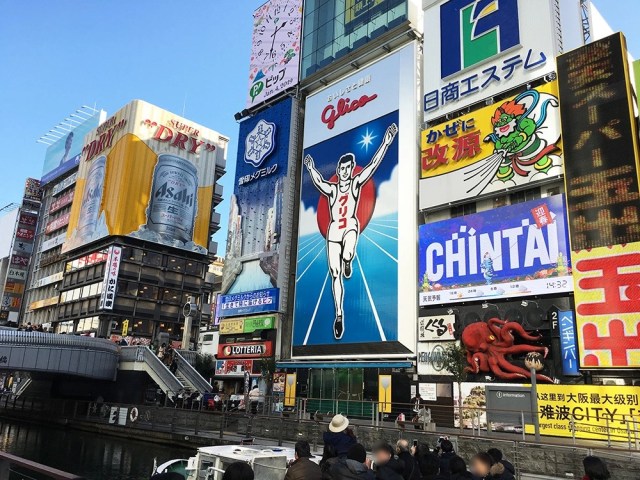
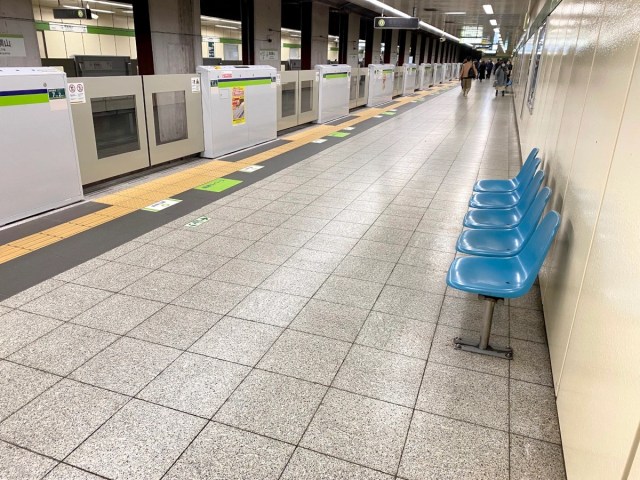
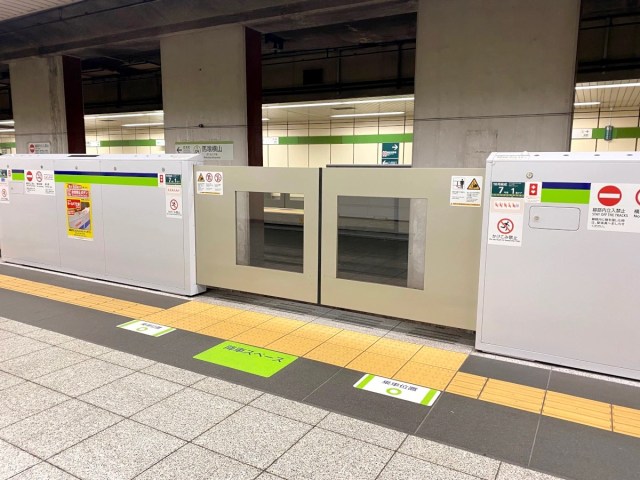
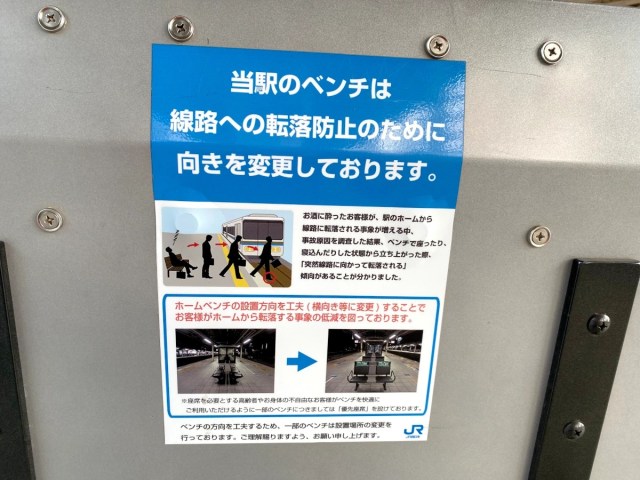
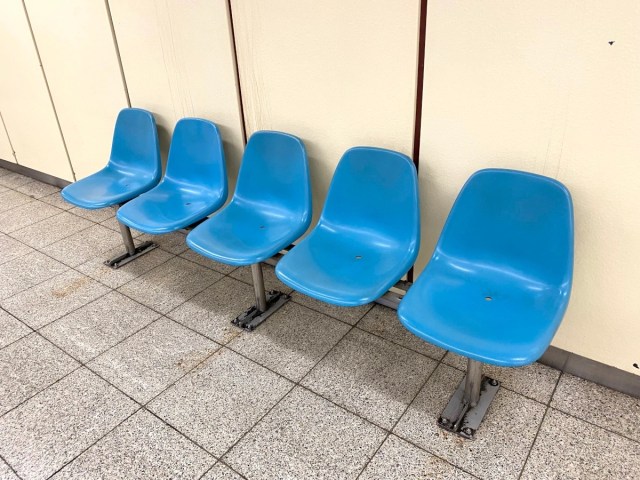
 Nozomi Shinkansen bullet train abolishes low-priced unreserved tickets during peak travel seasons
Nozomi Shinkansen bullet train abolishes low-priced unreserved tickets during peak travel seasons New Japanese mascot character: A train station monster that grabs children who don’t mind the gap
New Japanese mascot character: A train station monster that grabs children who don’t mind the gap Woman kills self jumping onto train tracks, delay causes conductor to jump off tracks at other station
Woman kills self jumping onto train tracks, delay causes conductor to jump off tracks at other station “Genius” child seat at food court in Japanese shopping mall goes viral
“Genius” child seat at food court in Japanese shopping mall goes viral Tokaido Shinkansen ending in-train food/drink sales for all non-first-class-passenger cars
Tokaido Shinkansen ending in-train food/drink sales for all non-first-class-passenger cars How to order snacks on a Shinkansen bullet train in Japan
How to order snacks on a Shinkansen bullet train in Japan Japan’s new difficult-to-drink-from beer glass protects your liver, but it’s a brutal experience
Japan’s new difficult-to-drink-from beer glass protects your liver, but it’s a brutal experience Burger King Japan suddenly adds Dr. Pepper and Dr. Pepper floats to its menu nationwide
Burger King Japan suddenly adds Dr. Pepper and Dr. Pepper floats to its menu nationwide Demon Slayer: Kimetsu no Yaiba gets new roller coaster attractions and food at Universal Studios Japan
Demon Slayer: Kimetsu no Yaiba gets new roller coaster attractions and food at Universal Studios Japan Hello, cosmetics! Clinique teams up with Hello Kitty this summer for first-time collaboration
Hello, cosmetics! Clinique teams up with Hello Kitty this summer for first-time collaboration Kyoto Tower mascot termination reveals dark side behind cute Japanese characters
Kyoto Tower mascot termination reveals dark side behind cute Japanese characters Nintendo history you can feel – Super NES, N64, and GameCube controllers become capsule toys
Nintendo history you can feel – Super NES, N64, and GameCube controllers become capsule toys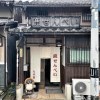 This Nara workshop has been making deer crackers for more than 100 years and offers tours【Photos】
This Nara workshop has been making deer crackers for more than 100 years and offers tours【Photos】 High-fashion Totoro cuddle purse is like an elegant stroll in the forest【Photos】
High-fashion Totoro cuddle purse is like an elegant stroll in the forest【Photos】 Legendary Melon Bread by Tokyo Banana returns after 20-year absence【Taste Test】
Legendary Melon Bread by Tokyo Banana returns after 20-year absence【Taste Test】 “The most Delicious Cup Noodle in history” – Japan’s French Cup Noodle wins our heart【Taste test】
“The most Delicious Cup Noodle in history” – Japan’s French Cup Noodle wins our heart【Taste test】 Starbucks releases a cute Frappuccino and Unicorn Cake…but not in Japan
Starbucks releases a cute Frappuccino and Unicorn Cake…but not in Japan McDonald’s Japan’s Soft Twist Tower: A phantom ice cream only sold at select branches
McDonald’s Japan’s Soft Twist Tower: A phantom ice cream only sold at select branches Yabai Ramen: What makes this Japanese ramen so dangerous?
Yabai Ramen: What makes this Japanese ramen so dangerous? Finally! Nintendo Japan expands Switch 8-bit controller sales to everybody, Online member or not
Finally! Nintendo Japan expands Switch 8-bit controller sales to everybody, Online member or not Japanese government wants to build luxury resorts in all national parks for foreign tourists
Japanese government wants to build luxury resorts in all national parks for foreign tourists To combat declining birth rate, Japan to begin offering “Breeding Visas” to foreigners
To combat declining birth rate, Japan to begin offering “Breeding Visas” to foreigners 10 things you should buy at 7-Eleven in Japan
10 things you should buy at 7-Eleven in Japan Studio Ghibli releases anime heroine cosplay dresses that are super comfy to wear
Studio Ghibli releases anime heroine cosplay dresses that are super comfy to wear Woman charged for driving suitcase without a license in Osaka
Woman charged for driving suitcase without a license in Osaka Studio Ghibli unveils My Neighbour Totoro miniature house model
Studio Ghibli unveils My Neighbour Totoro miniature house model Kyoto experiencing problems with foreign tourists not paying for bus fares, but not on purpose
Kyoto experiencing problems with foreign tourists not paying for bus fares, but not on purpose Fighting mild hunger with a Japanese soda that turns into jelly in the stomach【Taste test】
Fighting mild hunger with a Japanese soda that turns into jelly in the stomach【Taste test】 Studio Ghibli’s Howl’s Moving Castle tapestry unveiled in Japan for first time
Studio Ghibli’s Howl’s Moving Castle tapestry unveiled in Japan for first time McDonald’s new Happy Meals offer up cute and practical Sanrio lifestyle goods
McDonald’s new Happy Meals offer up cute and practical Sanrio lifestyle goods Sales of Japan’s most convenient train ticket/shopping payment cards suspended indefinitely
Sales of Japan’s most convenient train ticket/shopping payment cards suspended indefinitely Sold-out Studio Ghibli desktop humidifiers are back so Totoro can help you through the dry season
Sold-out Studio Ghibli desktop humidifiers are back so Totoro can help you through the dry season Japanese government to make first change to romanization spelling rules since the 1950s
Japanese government to make first change to romanization spelling rules since the 1950s Foreigner’s request for help in Tokyo makes us sad for the state of society
Foreigner’s request for help in Tokyo makes us sad for the state of society Ghibli founders Toshio Suzuki and Hayao Miyazaki contribute to Japanese whisky Totoro label design
Ghibli founders Toshio Suzuki and Hayao Miyazaki contribute to Japanese whisky Totoro label design Doraemon found buried at sea as scene from 1993 anime becomes real life【Photos】
Doraemon found buried at sea as scene from 1993 anime becomes real life【Photos】 Tokyo’s most famous Starbucks is closed
Tokyo’s most famous Starbucks is closed Princesses, fruits, and blacksmiths: Study reveals the 30 most unusual family names in Japan
Princesses, fruits, and blacksmiths: Study reveals the 30 most unusual family names in Japan Seats descend from ceiling on Japanese train to provide extra comfort for passengers【Video】
Seats descend from ceiling on Japanese train to provide extra comfort for passengers【Video】 “Passengers who don’t want to be groped, please use the rear train cars” announcement angers Japan
“Passengers who don’t want to be groped, please use the rear train cars” announcement angers Japan We tried teleworking from the Narita Express at Shinagawa Station with JR East’s Station Work
We tried teleworking from the Narita Express at Shinagawa Station with JR East’s Station Work Japanese train company issues official apology for “inexcusable” 25-second early departure
Japanese train company issues official apology for “inexcusable” 25-second early departure Japan’s Harajuku Station to be rebuilt ahead of 2020 Tokyo Olympics
Japan’s Harajuku Station to be rebuilt ahead of 2020 Tokyo Olympics Train driver sues Japan Rail…over 56 yen for a one-minute delay
Train driver sues Japan Rail…over 56 yen for a one-minute delay Japan’s train conductors would like to remind everyone not to attack them
Japan’s train conductors would like to remind everyone not to attack them Want to choose the name of Tokyo’s most important new station? Here’s your chance!
Want to choose the name of Tokyo’s most important new station? Here’s your chance! Japan Railways looking for love in all the weird places again with the Love Love Bench
Japan Railways looking for love in all the weird places again with the Love Love Bench Train etiquette poster features legendary Japanese folklore hero in an unusual plot twist
Train etiquette poster features legendary Japanese folklore hero in an unusual plot twist Use of selfie sticks now banned at 1,195 stations in Japan
Use of selfie sticks now banned at 1,195 stations in Japan The most beautiful train station in Japan? Award-winning design by Kengo Kuma wows travellers
The most beautiful train station in Japan? Award-winning design by Kengo Kuma wows travellers Free Shinkansen tickets for kids travelling with parents during special JR promotion
Free Shinkansen tickets for kids travelling with parents during special JR promotion Osaka earthquake hits city during peak hour, passengers freed after trains suspended
Osaka earthquake hits city during peak hour, passengers freed after trains suspended Tokyo train company makes sweet addition to stations so that birds can keep their nests in them
Tokyo train company makes sweet addition to stations so that birds can keep their nests in them
Leave a Reply